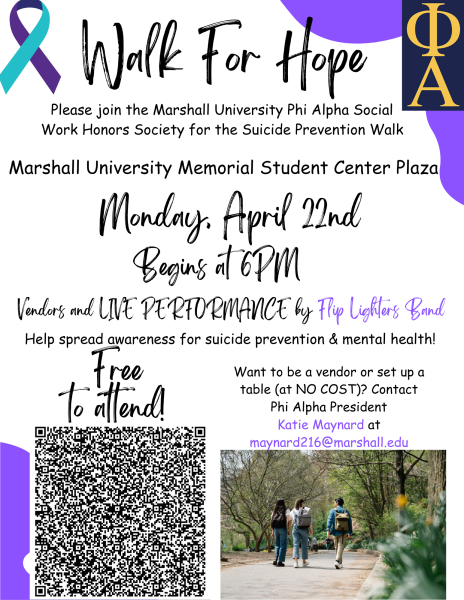Females Facing the Opioid Epidemic
Societal gender roles may be preventing females with long-term addiction disorders from receiving treatment for their addiction.
As West Virginia’s opioid epidemic continues to grow, societal gender roles and misinformation surrounding the opioid crisis may be creating obstacles for women with substance use disorder.
Ashley Ellis, recovery coach at the Recovery Point treatment facility in Huntington, said strict expectations for women can play a huge role in many individuals’ treatment processes.
“All women are expected by society to have certain roles,” Ellis said. “Drug addiction will take those away. Addiction can completely strip women of their identities.”
Serving as a female who has battled long-term addiction with alcohol, Ellis now helps other females through their addictions. She said misunderstandings surrounding drugs and alcohol are contributing to the state’s opioid crisis.
“People think that users and alcoholics are horrible people and that’s not true,” Ellis said. “This disease can affect anybody.”
With opioids becoming a widespread issue that’s affecting West Virginia, Kim Miller, director of corporate development at the Prestera Center, said that substance addiction affects men and women differently.
“Hormonal differences cause the road to addiction to be quicker for women,” Miller said.
Many obstacles may arise once a female becomes afflicted with a substance addiction, but according to Miller, the aspect of being a primary caregiver seems to be the leading cause in preventing treatment.
“Women are the bearers of children,” Miller said. “Because parenting responsibilities in our culture rest with the mom, substance use disorders cause the process to be disrupted. This may explain why fewer mothers make it into treatment.”
In addition to finding treatment, Amy Saunders, director of Marshall University’s Wellness Center, said the need for additional medical treatments, such as detox beds, serve as another obstacle for women.
“Only a few substance addictions require a person to detox, and even though heroin doesn’t require one, it’s still dangerous to not receive one,” Saunders said. “Limited numbers of detox beds will often prevent women from receiving the correct care before treatment.”
Ellis said once in treatment, many women may continue to struggle as they seek to connect with the counselors working to help them.
“Many times, counselors don’t even understand what a user is going through,” Ellis said. “Sometimes it takes meeting someone who’s went through treatment to educate a user about what to expect.”
Studies are now beginning to show a direct line between traumatic life events and substance use disorders, Miller said.
“If a person is abusing opioids, there is a 95 percent chance that they have suffered some sort of trauma,” Miller said. “We’re now seeing that women, sometimes mothers, are more commonly exposed to traumatic life events when compared to men.”
Particularly with a rise in women seeking to attain a desired substance, Miller said the potential risk of sex work is “running rampant” throughout the state.
“Sex work is definitely a product of drug addiction and is probably one of the biggest contributing factors for the development of substance use disorders in women,” Miller said.
By providing a way for women to maintain their addiction, Saunders said the sex work industry also serves as a common connection to other individuals battling with long-term addictions, particularly minorities.
“Many people don’t understand how prevalent sex work is in this area, not just for cisgender women, but specifically with transgender women and individuals within the LGBTQ community,” Saunders said. “Being pushed out of a family and into a homeless lifestyle increases the risk for any individual to be faced with drug addiction.”
With safe needle exchanges begin to arrive in different areas around the state, Mary Crouch, manager of Substance Abuse Treatment Services at Cabell Creek Health Center, said that although receiving clean needles will benefit some users, sanitary needles won’t be able to reach everyone.
“We’re now seeing many addicts try to clean their needles the best they can, but the risk is still incredibly high,” Crouch said. “There is still an enormous number of addicts who are sharing needles because it’s the only thing they can do.”
As drug users share needles and encounter the risk of spreading various infections, West Virginia has seen a recent rise in infections such as Hepatitis C and B, which Crouch said is due to a lack of prevention information.
“The addiction community is fairly connected,” Crouch said. “Almost everyone using is usually aware when things such as Hepatitis become an issue, but nobody receives information focused on prevention.”
Saunders said misinformation is actively one of the largest contributing factors for the current drug epidemic.
“There’s a huge amount of misinformation around all topics having to do with substance abuse, addiction and recovery; the public and the people using are equally misinformed,” Saunders said. “Educating people about the nature of addiction would need to be the first thing done in order to solve this issue.”
Despite addiction commonly being seen as an issue that only affects the user, Ellis said the public’s misinformation about the nature of addiction helps to contribute to the problem.
“A lot of people seem to think the key to recovery is wanting to stop abusing a substance, but that simply isn’t the case,” Ellis said. “Substance addiction is a disease of the mind and spiritual condition.”
While West Virginia’s opioid crisis begins to gain national attention, Saunders said she hopes future funding is provided to the state in order to ensure better education and new opportunities for those struggling with long-term addiction.
“Many treatment centers haven’t received sufficient education to correctly support someone with long-term addiction issues,” Saunders said. “Education and funding must come along to help improve this situation.”
As for improved treatment, Ellis said she would like to see more secure ways for women to maintain their sobriety after leaving a treatment faciality.
“More transitional living opportunities, also known as halfway houses, will be as crucial as long-term treatment services in the future,” Ellis said. “More treatment centers in general would benefit West Virginian because so many people need help.”
Not only will potential users need more resources for education, Miller said families and individuals connected to users will also need to be provided with information.
“Educating families will always be an important part of the solution,” Miller said. “Families are too often inadvertently contributing the problem.”
In addition to new educational resources and state funding, Crouch said she hopes to see more laxed laws surrounding the public’s use of overdose prevention drugs such as Narcan.
“The state’s overdose rate may be up, but the overdose death rate is down,” Crouch said. “That’s simply because more people have access to Narcan.”
Despite the opioid crisis’ effects on West Virginia’s men and women, Crouch said there is certainly a solution to the issue.
“Addiction is a huge destroyer of human life, but it doesn’t have to stay that way in this state,” Crouch said. “There are things we can do to prevent more issues but it’s going to take efforts from many different people.”
While the it may seem daunting, Crouch said she is optimistic for the future ahead in West Virginia.
“This isn’t a simple problem with a simple solution, but where there’s life there’s hope,” Crouch said. “Nobody wants this problem to destroy us and we aren’t going to let it happen.”
Joelle Gates can be contacted [email protected].
Your donation will help continue the work of independent student journalism at Marshall University. If you benefit from The Parthenon's free content, please consider making a donation.




